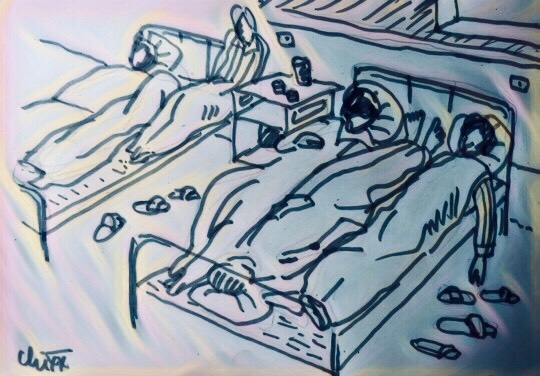 Opinion
Opinion

Bạch Mai Hospital, one of the biggest public hospitals in the country, has recently announced it would gradually wipe out so-called “serviced beds” or “beds on demand”.

|
| Illustration by Đàm Minh Trí |
By Chu Lan Hương
Bạch Mai Hospital, one of the biggest public hospitals in the country, has recently announced it would gradually wipe out so-called “serviced beds” or “beds on demand”.
It means all patients would be treated fairly in public healthcare facilities.
Of course, the plan was applauded by many people, especially those on low incomes, because they thought it was a way to wipe out the rich-poor gap in public health facilities and ensure all patients were treated fairly.
In prestigious public hospitals like Bạch Mai, overloading of patients is common, meaning a lot of patients have to share beds, with some even having to lie in hospital corridors.
Those who want to have their own beds have to pay extra.
To deal with this, hospitals set up “serviced beds” or “beds on demand”.
Hospitals expanded most rooms and departments, while doctors and nurses were willing to narrow their offices to have as many “serviced beds” as possible, because many high-income patients want to pay for more convenience and high-quality service in public hospitals.
In contrast to the well-furnished private rooms for the rich, there are crowded community rooms with dozens of beds which were shared by two or three patients.
Many people believed that hospitals had focused too much on investing in the service to collect more money from rich patients while the quality of treatment and beds for patients with medical insurance was not guaranteed.
This caused concern among patients.
Rich and poor arguments
Many people, especially those on low incomes, said all patients must be treated equally in public hospitals. Hospitals are where places for medical treatment, not for vacation. If someone had a lot of money, they should go to private hospitals where they would be treated with convenience.
“I was very happy to know that Bạch Mai would wipe out the serviced beds,” said Lê Thu Trà, a 50-year-old worker living in Hà Nội’s Thanh Xuân District.
“I felt sorry for myself when I had to share bed with another patient while in serviced departments, one patient could have a private room with an air-conditioner,” Trà said.
“It presented inequality in medical treatment at public hospitals,” the female worker said.
Hoàng Tiến Hùng, 50, a resident of Hoàng Mai District, said: “As a guard of a residential building, I could never afford serviced beds in hospitals. So, I have no way to share the bed with other patients who really want to stay comfortable.”
“Why don’t rich people go to private hospitals where they can enjoy convenience?”, Hùng said.
People thought that if there are no serviced beds in public hospitals, there will be better services for all.
However, the middle- and high-income people thought different.
“I could afford private hospitals, but I preferred public hospitals such as Bạch Mai or Việt Đức. Because they had more experienced and high-qualified doctors than in private hospitals,” said Nguyễn Ngọc Mai, a businesswoman.
“So, I found that public hospitals providing serviced beds was reasonable. The service brought profits which were used to invest in medical facilities and improved quality of healthcare services and health workers’ qualification,” Mai said.
“This benefited both the hospital and patients. So why would the serviced beds be wiped out?” the businesswoman said.
“I did not feel like I was stealing any chances from anyone,” she said.
Meanwhile, Phạm Văn Minh, a manager of a foreign-invested company in Hà Nội expressed his opinion that: “I trust doctors in public hospitals. This way is not fair to the rich.”
“Perhaps wiping out serviced beds in public hospitals would take chances of receiving the best medical treatment for high-income persons. The decision seemed to be in line with the market economic rules,” he said.
Best service for all
According to leaders of Bạch Mai Hospital, the plan was essential to narrow rich-and-poor gaps in the public healthcare facilities and ensure equality in healthcare access of all people.
“When the patient bed-sharing situation is finished, all patients would be offered similar service. It is equality,” said Doctor Dương Đức Hùng, deputy director of Bạch Mai Hospital.
“Once beds on demand no longer exist, we will offer a wide range of healthcare packages which prioritise patients’ benefits and treatment quality,” the doctor said.
Speaking with Kinh Tế & Đô Thị (Economy and City) newspaper, Dr. Trần Văn Phúc from Saint Paul Hospital in Hà Nội, said that to realise the plan, Bạch Mai Hospital must improve all services of medical examination and treatment to attract more patients as well as increase professional expertise and economic effects.
“This was an inevitable and necessary thing that should have been done a long time ago,” said Phúc.
“More patients mean more profit. It should not offer more high-cost serviced beds which took opportunities of fair treatment from other patients,” said the doctor.
It is true that socialising education and health care should not mean narrowing the chances of accessing public facilities of vulnerable groups. – VNS




